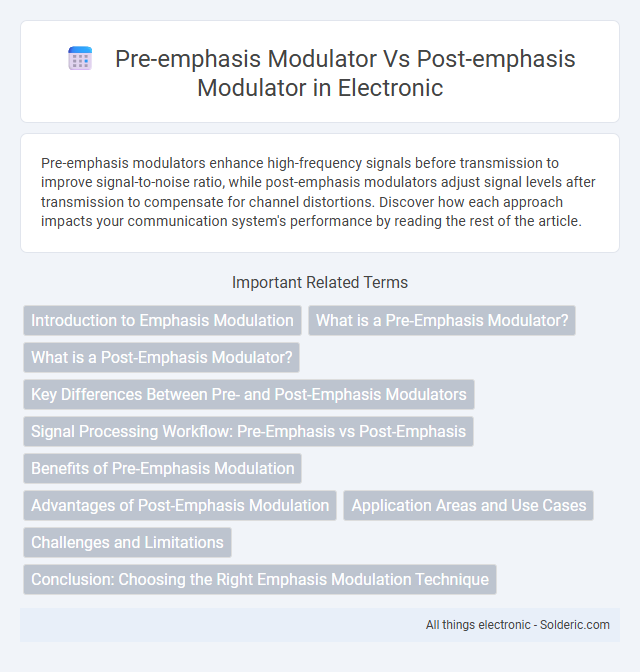Pre-emphasis modulators enhance high-frequency signals before transmission to improve signal-to-noise ratio, while post-emphasis modulators adjust signal levels after transmission to compensate for channel distortions. Discover how each approach impacts your communication system's performance by reading the rest of the article.
Comparison Table
| Feature | Pre-Emphasis Modulator | Post-Emphasis Modulator |
|---|---|---|
| Definition | Boosts high-frequency signals before modulation | Boosts high-frequency signals after modulation |
| Purpose | Improves signal-to-noise ratio during transmission | Enhances signal quality at the receiver end |
| Signal Processing Stage | Applied at transmitter before modulation | Applied at receiver after demodulation |
| Impact on Noise | Reduces high-frequency noise during transmission | Compensates for channel-induced distortion |
| Common Use | FM broadcasting and audio communication systems | FM receivers and audio playback devices |
| Effect on Bandwidth | May increase transmitted bandwidth due to high-frequency boost | No direct impact on transmitted bandwidth |
Introduction to Emphasis Modulation
Emphasis modulation enhances signal quality by boosting certain frequency components to improve transmission performance. Pre-emphasis modulators amplify high-frequency signals before transmission, reducing noise susceptibility, while post-emphasis modulators adjust these frequencies after reception to restore the original signal balance. This technique is crucial in communication systems like FM broadcasting and digital data transmission to maintain signal integrity and minimize distortion.
What is a Pre-Emphasis Modulator?
A Pre-Emphasis Modulator enhances signal quality by amplifying the higher frequency components before transmission, which helps reduce the impact of noise and interference in communication systems. This technique improves signal-to-noise ratio by emphasizing rapid changes in the signal, making it easier to recover the original information at the receiver end. It is commonly used in FM broadcasting and digital communication to maintain signal integrity and clarity.
What is a Post-Emphasis Modulator?
A Post-Emphasis Modulator enhances the high-frequency components of a signal after modulation to improve the signal-to-noise ratio during transmission. It reduces noise effects and distortion by applying frequency emphasis at the output stage, making the received signal clearer and more accurate. Your communication system benefits from this by maintaining signal integrity in environments with high interference or long-distance transmission.
Key Differences Between Pre- and Post-Emphasis Modulators
Pre-emphasis modulators enhance the high-frequency components of a signal before transmission to improve signal-to-noise ratio, while post-emphasis modulators apply gain to high frequencies after reception to restore original signal balance. Pre-emphasis is critical in reducing noise in FM broadcasting and digital communication by boosting high-frequency details upfront. Post-emphasis compensates for the pre-emphasis effect, ensuring accurate audio reproduction by attenuating the boosted frequencies after signal demodulation.
Signal Processing Workflow: Pre-Emphasis vs Post-Emphasis
Pre-emphasis modulators apply signal boosting to high-frequency components before transmission, improving signal-to-noise ratio and reducing distortion during channel transmission. Post-emphasis modulators restore or enhance these frequencies after demodulation, ensuring audio clarity and fidelity in the final output. Understanding the contrast in these signal processing workflows helps optimize your communication system's performance based on transmission and reception conditions.
Benefits of Pre-Emphasis Modulation
Pre-emphasis modulation enhances signal quality by boosting high-frequency components before transmission, reducing the impact of noise and interference. This technique improves the overall signal-to-noise ratio, ensuring clearer audio or data reception in communication systems. Your system benefits from reduced distortion and improved fidelity, particularly in environments with high spectral loss.
Advantages of Post-Emphasis Modulation
Post-emphasis modulation improves signal integrity by applying emphasis after the main modulation process, reducing vulnerability to noise and distortion during transmission. This approach enhances overall signal-to-noise ratio and minimizes high-frequency attenuation, resulting in clearer audio or data signals. Your system benefits from increased robustness and better performance in challenging communication environments with post-emphasis techniques.
Application Areas and Use Cases
Pre-emphasis modulators are commonly applied in communication systems to improve signal-to-noise ratio by amplifying higher-frequency components before transmission, making them ideal for FM broadcasting and audio processing where noise reduction is critical. Post-emphasis modulators, on the other hand, are utilized in applications like television broadcasting and digital audio to restore frequency balance after transmission, compensating for channel-induced signal degradation. Your choice between pre-emphasis and post-emphasis modulators depends on whether noise suppression during transmission or signal correction after reception is more critical for your specific use case.
Challenges and Limitations
Pre-emphasis modulators face challenges in accurately compensating for high-frequency attenuation without amplifying noise, which can degrade overall signal quality. Post-emphasis modulators often struggle with timing alignment issues, leading to potential distortion and reduced effectiveness in signal enhancement. Your choice between these modulators depends on balancing noise sensitivity and distortion risks in specific communication environments.
Conclusion: Choosing the Right Emphasis Modulation Technique
Pre-emphasis modulators enhance high-frequency signal components before transmission to improve signal-to-noise ratio but may increase spectral bandwidth and complexity. Post-emphasis modulators apply emphasis after signal generation, simplifying transmitter design while relying on receiver-side de-emphasis for optimal performance. Selecting the right emphasis modulation technique depends on system requirements such as bandwidth constraints, noise environment, and overall design complexity, with pre-emphasis favored in high-noise channels and post-emphasis preferred for simpler implementation and lower transmitter complexity.
Pre-emphasis modulator vs post-emphasis modulator Infographic

 solderic.com
solderic.com